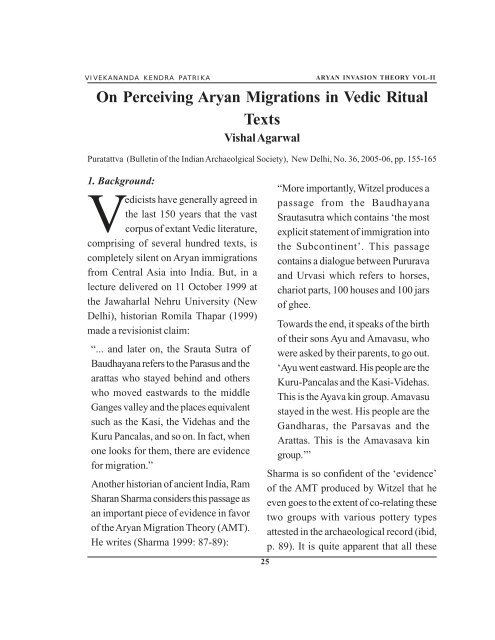Aryan Invasion Theory - Publication - Vivekananda Kendra
Aryan Invasion Theory - Publication - Vivekananda Kendra
Aryan Invasion Theory - Publication - Vivekananda Kendra
Create successful ePaper yourself
Turn your PDF publications into a flip-book with our unique Google optimized e-Paper software.
VIVEKANANDA KENDRA PATRIKA ARYAN INVASION THEORY VOL-II<br />
On Perceiving <strong>Aryan</strong> Migrations in Vedic Ritual<br />
Texts<br />
Vishal Agarwal<br />
Puratattva (Bulletin of the Indian Archaeolgical Society), New Delhi, No. 36, 2005-06, pp. 155-165<br />
1. Background:<br />
Vedicists have generally agreed in<br />
the last 150 years that the vast<br />
corpus of extant Vedic literature,<br />
comprising of several hundred texts, is<br />
completely silent on <strong>Aryan</strong> immigrations<br />
from Central Asia into India. But, in a<br />
lecture delivered on 11 October 1999 at<br />
the Jawaharlal Nehru University (New<br />
Delhi), historian Romila Thapar (1999)<br />
made a revisionist claim:<br />
“... and later on, the Srauta Sutra of<br />
Baudhayana refers to the Parasus and the<br />
arattas who stayed behind and others<br />
who moved eastwards to the middle<br />
Ganges valley and the places equivalent<br />
such as the Kasi, the Videhas and the<br />
Kuru Pancalas, and so on. In fact, when<br />
one looks for them, there are evidence<br />
for migration.”<br />
Another historian of ancient India, Ram<br />
Sharan Sharma considers this passage as<br />
an important piece of evidence in favor<br />
of the <strong>Aryan</strong> Migration <strong>Theory</strong> (AMT).<br />
He writes (Sharma 1999: 87-89):<br />
25<br />
“More importantly, Witzel produces a<br />
passage from the Baudhayana<br />
Srautasutra which contains ‘the most<br />
explicit statement of immigration into<br />
the Subcontinent’. This passage<br />
contains a dialogue between Pururava<br />
and Urvasi which refers to horses,<br />
chariot parts, 100 houses and 100 jars<br />
of ghee.<br />
Towards the end, it speaks of the birth<br />
of their sons Ayu and Amavasu, who<br />
were asked by their parents, to go out.<br />
‘Ayu went eastward. His people are the<br />
Kuru-Pancalas and the Kasi-Videhas.<br />
This is the Ayava kin group. Amavasu<br />
stayed in the west. His people are the<br />
Gandharas, the Parsavas and the<br />
Arattas. This is the Amavasava kin<br />
group.’”<br />
Sharma is so confident of the ‘evidence’<br />
of the AMT produced by Witzel that he<br />
even goes to the extent of co-relating these<br />
two groups with various pottery types<br />
attested in the archaeological record (ibid,<br />
p. 89). It is quite apparent that all these

















